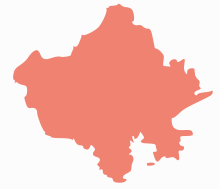Kota, Rajasthan
Kota (/ˈkoʊtə/ (![]()
Kota | |
|---|---|
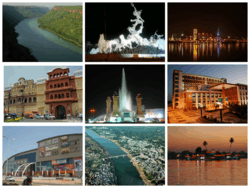 Clockwise from the top: Aerial View of Chambal River, Ghatotkachh Circle, Seven Wonders Park, Bansal Classes, Jagmandir Palace, Aerial view of a part of Kota, City Mall, Garh Palace, Aerodrome Circle | |
 Kota  Kota | |
| Coordinates: 25°0′0″N 76°10′0″E | |
| Country | India |
| State | Rajasthan |
| District | Kota |
| Division | Kota Division ( Hadoti Region ) |
| Named for | Kotia Bhil[1] |
| Government | |
| • Type | Democratic |
| • Body | Municipal Corporation |
| • Mayor | Prasun Agarwal (BJP) |
| • Member of Parliament Kota-Bundi | Om Birla (BJP) |
| • Member of Legislative Assembly Kota South | Pranav Agarwal (BJP) |
| • Member of Legislative Assembly Kota North | Shanti Kumar Dhariwal (INC) |
| Area | |
| • Total | 221.36 km2 (85.47 sq mi) |
| Elevation | 271 m (889 ft) |
| Population | |
| • Total | 1,001,694 |
| • Rank | 46th |
| • Density | 4,500/km2 (12,000/sq mi) |
| Languages | |
| • Official | Hindi, English |
| • Native | Rajasthani, Harauti |
| Time zone | UTC+5:30 (IST) |
| PIN | 324001 to 324011 and 324022 |
| Telephone code | 0744 |
| ISO 3166 code | RJ-IN |
| Vehicle registration | RJ-20 |
| Sex ratio | 895 ♀/♂ |
| Website | kotamc |
The city of Kota was once the part of the erstwhile Rajput kingdom of Bundi. It became a separate princely state in the 17th century. Apart from the several monuments that reflect the glory of the town, Kota is also known for its palaces and gardens.[10][11] Mahesh Vijay of Bhartiya Janta Party is the current Mayor of Kota.[12] In 2013, Kota was ranked the second most livable city in the state (after Jaipur) and forty-first in the country among 50 cities.[13] The city was also included among 98 Indian cities for Smart Cities Mission initiated by Indian Prime Minister Narendra Modi in 2015[14] and was listed at 67th place after results of first round were released following which top 20 cities were further selected for funding in the immediate financial year.[15] It is popular among the youth of India for its coaching institutes for engineering and medical entrance examinations. Many students come to Kota to prepare for the IIT JEE and NEET.[16]
History
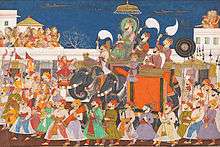
The history of the city dates back to the 12th century AD when Rao Deva, a Chauhan Rajput chieftain belonging to the Hada clan conquered the territory and founded Bundi and Hadoti. Later, in the early 17th century, during the reign of the Mughal Emperor Jahangir, the ruler of Bundi – Rao Ratan Singh, gave the smaller principality of Kota to his son, Madho Singh. Since then Kota became a hallmark of the Rajput gallantry and culture.[17]
The independent state of Kota became a reality in 1631 when Rao Madho Singh, the second son of Rao Ratan of [Bundi] was made the ruler, by the Mughal Emperor Jahangir.[18] Soon Kota outgrew its parent state to become bigger in area, richer in revenue and more powerful. Maharao Bhim Singh played a pivotal role in Kota's history, having held a 'Mansab'[18] of five thousand and being the first in his dynasty to have the title of Maharao. Zalim Singh, a diplomat and statesman, emerged as another prominent figure of the state in the 18th century. Although initially being a general of Kota's army, he rose to the regent of the kingdom after the king died leaving a minor on the throne.[17] He remained a direct administrator of the state. In 1817, a treaty of friendship was signed between him and the British on his condition of carving out part from the existing state for his descendants resulting in Jhalawar coming into existence in 1838.[17] During the colonial period, firebrand social activist Guru Radha Kishan organised the masses against the policies of the government. He left Kota after local administration came to know about the arrest warrant issued against him for his participation in Indian Independence activities.
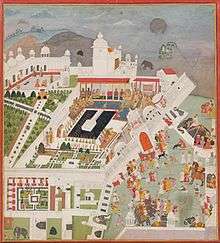
| Princely city: Kota (कोटा) | |
| Region | Hadoti |
| 19th-century flag |  |
| Independence from: | Bundi State |
| State existed: | 1579–1949 |
| Dynasties | Rajput Chauhan Hada |
| Capital | Kota |
Princely city of Kota
Kota became independent in 1579, after Bundi state in Hadoti region had become weak. Then, Kota ruled the territory which now is Kota district and Baran district.
Geography
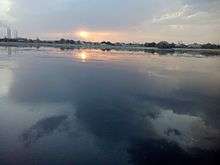
Kota is located along the banks of the Chambal River in the southern part of Rajasthan. It is the 3rd largest city of Rajasthan after Jaipur and Jodhpur. The cartographic coordinates are 25.18°N 75.83°E.[19] It covers an area of 527 km2.[2][20] It has an average elevation of 271 metres (889 ft). The district is bound on the north and north west by Sawai Madhopur, Tonk and Bundi districts. The Chambal River separates these districts from Kota district, forming the natural boundary.
The city of Kota is situated at a centre of the southeastern region of Rajasthan a region very widely known as Hadoti, the land of the Hadas. Kota lies along the banks of the Chambal river on a high sloping tableland forming a part of the Malwa Plateau. The general slope of the city is towards the north. The comparatively rocky, barren and elevated land in the southern part of city descends towards a plain agricultural land in the north. The Mukundara hills run from southeast to northwest axis of the town.
Kota has fertile land and greenery with irrigation facilities through canals. The two main canals; called as left main canal (towards Bundi) and right main canal (towards Baran) originate from the reservoir created by Kota Barrage.[21][22] The tributaries of these canals make up a network in the city and surrounding areas of [Rajasthan] and Madhya Pradesh and supplements the irrigation of these areas.[22]
Climate
| Kota | ||||||||||||||||||||||||||||||||||||||||||||||||||||||||||||
|---|---|---|---|---|---|---|---|---|---|---|---|---|---|---|---|---|---|---|---|---|---|---|---|---|---|---|---|---|---|---|---|---|---|---|---|---|---|---|---|---|---|---|---|---|---|---|---|---|---|---|---|---|---|---|---|---|---|---|---|---|
| Climate chart (explanation) | ||||||||||||||||||||||||||||||||||||||||||||||||||||||||||||
| ||||||||||||||||||||||||||||||||||||||||||||||||||||||||||||
| ||||||||||||||||||||||||||||||||||||||||||||||||||||||||||||
Kota has a semi-arid climate (Köppen climate classification BSh) with high temperatures throughout the year. Summers are long, hot and dry, starting in late March and lasting till the end of June. The temperatures average above 40 °C in May and June, frequently exceed 45 °C with temperatures as high as 48.4 °C also been recorded.[23] The monsoon season follows with comparatively lower temperatures, but higher humidity and frequent, torrential downpours. The monsoons subside in October and temperatures rise again. The brief, mild winter starts in late November and lasts until the last week of February. Temperatures hover between 26.7 °C (max) to 12.0 °C (min). This can be considered the best time to visit Kota because of intense heat in the summer.[24]
The average annual rainfall in the Kota district is 660.6 mm.[20] Most of the rainfall can be attributed to the southwest monsoon which has its beginning around the last week of June and may last till mid-September. Pre-monsoon showers begin towards the middle of June with post-monsoon rains occasionally occurring in October. The winter is largely dry, although some rainfall does occur as a result of the Western Disturbance passing over the region.[24]
| Climate data for Kota (A) | |||||||||||||
|---|---|---|---|---|---|---|---|---|---|---|---|---|---|
| Month | Jan | Feb | Mar | Apr | May | Jun | Jul | Aug | Sep | Oct | Nov | Dec | Year |
| Record high °C (°F) | 33.4 (92.1) |
37.0 (98.6) |
42.7 (108.9) |
48.5 (119.3) |
48.4 (119.1) |
47.3 (117.1) |
44.3 (111.7) |
41.0 (105.8) |
41.0 (105.8) |
40.4 (104.7) |
38.0 (100.4) |
33.2 (91.8) |
48.5 (119.3) |
| Average high °C (°F) | 23.7 (74.7) |
26.9 (80.4) |
32.9 (91.2) |
38.8 (101.8) |
42.1 (107.8) |
40.0 (104.0) |
34.2 (93.6) |
32.0 (89.6) |
33.7 (92.7) |
34.3 (93.7) |
29.9 (85.8) |
25.3 (77.5) |
32.8 (91.1) |
| Average low °C (°F) | 10.9 (51.6) |
13.7 (56.7) |
19.1 (66.4) |
25.0 (77.0) |
29.3 (84.7) |
29.2 (84.6) |
26.5 (79.7) |
25.4 (77.7) |
25.0 (77.0) |
21.8 (71.2) |
16.3 (61.3) |
11.9 (53.4) |
21.2 (70.1) |
| Record low °C (°F) | 1.7 (35.1) |
4.5 (40.1) |
8.6 (47.5) |
14.0 (57.2) |
20.0 (68.0) |
18.8 (65.8) |
20.4 (68.7) |
18.4 (65.1) |
16.4 (61.5) |
14.1 (57.4) |
7.1 (44.8) |
3.8 (38.8) |
1.7 (35.1) |
| Average precipitation mm (inches) | 5.4 (0.21) |
4.4 (0.17) |
4.0 (0.16) |
3.2 (0.13) |
10.3 (0.41) |
62.9 (2.48) |
257.0 (10.12) |
245.8 (9.68) |
98.5 (3.88) |
19.6 (0.77) |
7.8 (0.31) |
3.5 (0.14) |
722.4 (28.46) |
| Average rainy days | 0.9 | 1.0 | 0.6 | 0.4 | 2.1 | 6.9 | 13.1 | 15.2 | 5.6 | 1.6 | 1.2 | 0.5 | 49.1 |
| Average relative humidity (%) | 48 | 38 | 25 | 19 | 23 | 43 | 67 | 74 | 58 | 40 | 41 | 48 | 44 |
| Source 1: Kota weather, India Meteorological Department: (Kota (A) record highs and lows up to 2010),[25] Monthly mean maximum and minimum temperature and rainfall (1961–2000)[26] | |||||||||||||
| Source 2: NOAA (1971–1990)[27] | |||||||||||||
Demographics
According to 2011 Census of India, Kota City had a population of 1,001,694 of which male and female are 528,601 and 473,093 respectively.[4][29] The provisional results of census 2011 reported city's population as 1,001,365.[30] The urban agglomeration of Kota consists of city only.[29][31] The sex ratio was 895 and 12.14% were under six years of age. The effective literacy rate was 82.80%, with male literacy at 89.49% and female literacy at 75.33%.[29]
Harauti, a dialect of Rajasthani is widely spoken in Kota with Hindi, Marwari and English being the other languages spoken.[32]
According to 2011 census, Hinduism is the majority religion in the city practised by about 80.5% of the population. Muslims form large minorities (15.9%) followed by Jains (2.2%), Sikhs (0.9%) and Christians (0.4%).[28]
Government institutions and courts
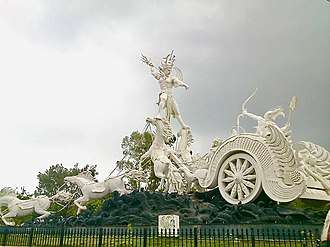
Governmental institutions in Kota include:
- Municipal Corporation
- Collectorate
- Office of the Divisional Commissioner
- Rajasthan Housing Board
- Command Area Development (CAD)
- Urban Improvement Trust (UIT)
- Office of the Superintendent of Police, Inspector General of Police and the Income Tax commissioner of Kota range.
- Office of the Divisional Railway Manager, Kota Division, West Central Railway
- Office of Deputy Commissioner of central excise and service tax
Instrumentation Ltd is a Public Sector company based in Kota.[33] Its clientele includes public sector entities such as the Indian Railways, BSNL and VSNL. Presently, it has been shut down.
The District court provides court and notary services.[34]
Economy
The city is the trade centre for an area in which cotton, millet, wheat, coriander and oilseeds are grown; industries include cotton and oilseed milling, textile weaving, distilling, dairying, and the manufacture of metal handcrafts.[35] Kota also has an extensive industry of stone-polishing (tiles) of a stone called Kota Stone, used for the floor and walls of residential and business buildings. Since last 15 years Kota has emerged as an Education hub of the country as producing excellent results in IIT-JEE and medical entrance exams.[6][36][37]
Kota Doria or Kota Doriya and Sarees
Weaving in Kota was started by Maharana Bhimdev in the 18th century.[38]
The Kota saris like most traditional piece of work had started becoming lost before designer Vidhi Singhania moved to Kota and started working with the workers to revive its market.[39] Many textile shops in the city sell different varieties of Kota doriya. These saris have become one of the trademarks of the city.[40]
Kota stone
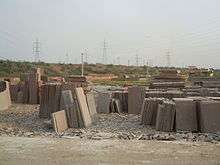
The fine-grained variety of limestone quarried from Kota district is known as Kota stone, with rich greenish-blue and brown colours. Kota stone is tough, non-water-absorbent, non-slip, and non-porous. The varieties include Kota Blue Natural, Kota Blue Honed, Kota Blue Polished, Kota Blue Cobbles, Kota Brown Natural and Kota Brown Polished.[41]
Industries
Kota is one of the industrial hubs in northern India, with chemical, cement, engineering and power plants based there. The total number of industrial units in the district in 2010–11 stood at 12908 with 705 registered units.[42] The district power plants show annual growth of 15–20% due to their strategic locations.[42]
Power plants
Kota is surrounded by five power stations within its 50 km radius.
- Kota Super Thermal Power Plant – thermal[43]
- Rajasthan Atomic Power Station in Rawatbhata Chittorgarh district (65 kilometres from Kota) – nuclear[44]
- NTPC Anta Gas Power Plant in Antah Baran district (50 kilometers from Kota) – gas
- Jawahar Sagar Power Plant – hydro[45]
- Kalisindh Thermal Power Station (in Jhalrapatan, Jhalawar) – thermal
Education
The city is specially known in India as a center for preparation of various national level competitive examinations through which the students seek admissions in various engineering and medical colleges of the country. Often termed as the "Kota Factory", the town contains more than 40 large coaching institutes for aspiring students trying to pass entrance exams for Indian Institutes of Technology (IIT), through the IIT JEE, other engineering colleges and prominent medical colleges of India.[16] Of the 40 large coaching institutes in the town, the most prominent are Allen, Resonance, Bansal, Vibrant and Career Point.[46]
Since 2000, the city has emerged as a popular coaching destination for competitive exams preparation and for profit educational services. The education sector of Kota has become one of the major contributors to the city's economy.[47] Kota is popularly referred to as "the coaching capital of India".[6][36][48] Over 1.5 lakh students from all over the country flock every year towards the city for preparation of various exams such as IIT-JEE and NEET-UG etc.[49][50][51][52] Many hostels and PGs are located in Kota near the vicinity of coaching centres for students. Students live here for 2–3 years and prepare for the exams. The annual turnover of the Kota coaching industry is about ₹1500 crore.[53]
Kota's emergence as a coaching hub began in 1985 when Vinod Kumar Bansal, an engineer working for J. K. Synthetics Ltd, set up Bansal Classes that eventually became Bansal Classes Private Limited.[54]
Student Suicides
In the past few years, reports of students committing suicide in the city have increased. As per reports, students feel stressed and get pressurized in order to crack their target competitive exam. As per National Crime Records Bureau report of 2014, 45 suicide cases of students were reported in the city. In year 2015, 17 such cases were found.[55] For the same cause, many coaching centers have also appointed counsellors and are organising recreational activities to help students.[56][57][58][59]
Medical and Engineering Colleges
- Government Medical College, Kota
- University Engineering College, Kota
Universities
- Agriculture University, Kota
- Career Point University, Kota
- Rajasthan Technical University
- Vardhaman Mahaveer Open University
- University of Kota
- Indian Institute of Information Technology
Places of interest
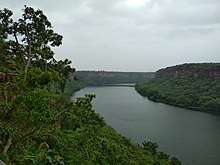
Some of the popular visitor attractions in and nearby the city include Chambal Garden, Seven Wonders Park, Kishore Sagar Lake, Jag Mandir, Garh Palace, Chatra Vilas Garden, Godavari Dham Temple, Garadia Mahadev Temple, Kota Zoological Park, Maharao Madho Singh Museum, Kota Government Museum, Brijraj Bhawan Palace, Abheda Mahal, Azamgarh Gurudwara Sahib, Hanging Rock Fountain, Royal Cenotaphs at Keshar Bagh, Kota Barrage, Adharshila Dargah, Darrah National Park and Jawahar Sagar Dam.[60][61][62][63][64]
Transport
Kota is well connected with road and rail to all major cities within Rajasthan as well as those located outside the state.[65]
Roadways
National highway No.12 (Jaipur—Jabalpur) and National Highway No.76 pass through the city.[66] National Highway No.76 is a part of East-West Corridor. The total road length in Kota district is 2,052 km. as of March 2011.
Railways
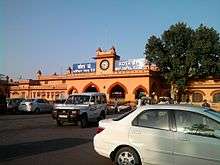
Kota is well connected to all the major cities of India with rail. Kota Junction is one of the divisions in West Central Railway.[67] It is a station on the New Delhi–Mumbai main line. There are four railway stations within Kota and in its vicinity. Another suburban station of South Kota city is Dakaniya Talav Railway station which has a stoppage of Avadh Express, Dehradun Express and Ranthambore Express.[68]
The city is a halt for over 150 trains,[69] including Mumbai Rajdhani Express, August Kranti Rajdhani Express, Mumbai New Delhi Duronto Express, Indore–Jaipur Express, Udaipur SuperFast (Delhi – Udaipur City Express), Dayodaya Express (Jaipur – Jabalpur Express / Ajmer – Jabalpur Express), Jodhpur – Indore Intercity, Hazrat Nizamuddin - Indore Express, Garbha Express, Marusagar Express (Ajmer – Ernakulam Express / Ernakulam Express), Jaipur – Mysore Express, Jaipur – Chennai Express, Jaipur – Coimbatore Express, Jodhpur – Puri Express, Jodhpur – Bhopal Express.
The Delhi—Mumbai railway line passes through the Kota Junction. The district has 148.83 km of railway line in the Kota – Ruthia section, 98.72 km on Nagda—Mathura (Mumbai-Delhi) section and 24.26 km on Kota —Chittorgarh section.
A broad-gauge railway facility between Kota and Jodhpur via Jaipur exists.
Airways
Kota Airport has had no scheduled services operating since 1999.[70] The nearest international airport is Jaipur International Airport situated 250 km away from Kota. A new airport construction plan was build and it things go fine there might be a greenfield airport in Kota scheduled for 2022
Sports
The city is home to Jay Kaylon Cricket Stadium located in Nayapura area. Among several matches, six Ranji Trophy matches have been played in the stadium.[71][72] The stadium also hosted RCL T20 2016, an inter state cricket league with six participating teams.[73]
Media
Television
There are five major regional TV Channels in Kota.[74]
- DD Rajasthan
- Media House Rajasthan(MHR News)
- ETV Rajasthan
- India news Rajasthan
- Jan TV
A wide range of other Hindi, English and other language channels are accessible via cable subscription and direct-broadcast satellite services. Dish TV, Tata Sky, Radiant Digitek, Airtel digital TV are entertainment services in Kota.
Newspapers
Major daily newspapers in Kota[75][76][77] include:
- Rajasthan Patrika (Hindi)
- Dainik Bhaskar (Hindi)
- Dainik Navajyoti (Hindi)[78]
- The Times of India (English)
- Hindustan Times (English)
Radio
There are five radio stations in Kota, with four broadcasting on the FM band, and one All India Radio station broadcasting on the AM band.
- Big FM (92.7 MHz)[79]
- My FM (94.3 MHz)[80]
- FM Tadka (95.0 MHz)[81]
- All India Radio (102.0 MHz)[82]
- Radio City (91.1 MHz)[83]
Notable people
- Om Birla
- Vinod Kumar Bansal
- Bhim Singh II
- Lalit Kishore Chaturvedi
- Krishana Kumar Goyal
- Shail Hada
- Taj Haider
- Hari Kumar Audichya
- Ijyaraj Singh
- Raghuveer Singh Koshal
- Rulers of Kota, Rajasthan
- Shiv Kumari of Kotah
- Bhuvaneshwari Kumari
- Nikita Lalwani
- Pramod Maheshwari
- Umed Singh II
- Aniruddh Singh
References
- "जिनके नाम से कोटा का नाम पड़ा 300 साल बाद लगाई जाएगी उनकी प्रतिमा". Dainik Bhaskar (in Hindi). 30 July 2012.
- "Kota District Census 2011 Handbook: VILLAGE AND TOWN WISE PRIMARY CENSUS ABSTRACT (PCA)" (PDF). Census of India. p. 29 (pdf) Urban Section. Archived (PDF) from the original on 27 April 2018. Retrieved 19 April 2016.
- "2011 census: Kota Municipal Corporation Demographics". Censusofindia.gov.in. Retrieved 7 April 2016.
- "Kota (Kota, Rajasthan, India) – Population Statistics and Location in Maps and Charts – City Population". Citypopulation. de. Archived from the original on 20 August 2016. Retrieved 20 July 2016.
- "Major Cities in Rajasthan". Indiatravelportal.com. Archived from the original on 3 August 2013. Retrieved 27 September 2013.
- Anjali Puri (31 December 2015). "How Kota became India's capital for educational coaching". Business Standard. Archived from the original on 4 January 2016. Retrieved 11 January 2016.
- "I always try to write beyond genres:Interview With Harsh Agarwal, Author of the book 'An Excursion of Insight'". Merry Brains. 12 August 2014. Archived from the original on 25 June 2018. Retrieved 25 June 2018.
- "Book Launch – The Life in a Nutshell". UdaipurBlog. 24 December 2011. Archived from the original on 25 June 2018. Retrieved 25 June 2018.
- DSOUZA, DILIP (April 2012). "Get to the Top – Coaching and poaching in a Rajasthani city transformed by the business of aspiration". The Caravan. Archived from the original on 25 June 2018. Retrieved 25 June 2018.
- "Tours to Kota". Indian Horizons. Archived from the original on 17 August 2016. Retrieved 5 June 2016.
- "Lakes and Gardens in Kota". Indian Horizons. Archived from the original on 17 August 2016. Retrieved 5 June 2016.
- "कोटा में महेश विजय होंगे नए महापौर". Rajasthan Patrika. 26 November 2014. Archived from the original on 23 June 2016. Retrieved 24 May 2016.
- "Liveability Index: The Best Cities in India" (PDF). Competitiveness.in. p. 22. Archived from the original (PDF) on 25 March 2016. Retrieved 2 July 2016.
- Mehboob Jeelani (28 August 2015). "Centre unveils list of 98 smart cities; UP, TN strike it rich". The Hindu. Archived from the original on 26 November 2016. Retrieved 24 May 2016.
- "Ranking of Smart Cities" (PDF). Ministry of Urban Development. Archived (PDF) from the original on 22 March 2016. Retrieved 24 May 2016.
- "Kota coaching factory – Panic calls: 14-hr days, morning nightmares". The Indian Express. 26 November 2015. Archived from the original on 27 December 2018. Retrieved 27 December 2018.
- "About Kota". Rajasthan Travel. Archived from the original on 8 September 2016. Retrieved 24 June 2016.
- "History of Kota". Maps of India. Archived from the original on 8 August 2016. Retrieved 5 June 2016.
- "Falling Rain Genomics, Inc – Kota". Archived from the original on 11 March 2007. Retrieved 2 November 2006.
- Statistics by Govt. of Rajasthan Archived 29 June 2007 at the Wayback Machine
- "COMMAND AREA DEVELOPMENT CHAMBAL, KOTA". kotadivision.nic.in. Archived from the original on 23 March 2012. Retrieved 3 July 2016.
- "Chambal Valley Project". Water Resources Department, Govt. of Rajasthan. Archived from the original on 4 March 2016. Retrieved 3 July 2016.
- "Heat wave claims 10 lives; Kota hottest at 48.4 °C". Zee News. 26 May 2010. Archived from the original on 21 September 2016. Retrieved 23 April 2016.
- "Kota Climate details: Monthly Temperature, Rainfall and Sunshine". Weather and climate.com. Archived from the original on 5 June 2016. Retrieved 8 May 2016.
- "Ever Recorded Maximum Temperature, Minimum Temperature and 24 Hours Heaviest Rainfall up to 2010" (PDF). India Meteorological Department. p. 64. Archived from the original (PDF) on 21 May 2013. Retrieved 20 May 2016.
- "Monthly mean maximum & minimum temperature and total rainfall based upon 1901–2000 data" (PDF). India Meteorological Department. p. 38. Archived from the original (PDF) on 11 April 2016. Retrieved 6 June 2016.
- "Kota (A) Climate Normals 1971–1990". National Oceanic and Atmospheric Administration. Retrieved 22 December 2012.
- "Religion in Kota". Census 2011. Archived from the original on 22 December 2015. Retrieved 16 December 2015.
- Kota City Census report Archived 9 February 2013 at the Wayback Machine census 2011
- "Provisional Population Totals, Census of India 2011; Cities having population 1 lakh and above" (PDF). Office of the Registrar General & Census Commissioner, India. Archived (PDF) from the original on 7 May 2012. Retrieved 26 March 2012.
- Kota District Demographics, Census 2011 Archived 10 July 2015 at the Wayback Machine census India 2011
- "Languages of Rajasthan". Rajasthan Tourism. Archived from the original on 9 June 2016. Retrieved 24 May 2016.
- "Instrumentation Ltd Kota: Official website". Archived from the original on 17 August 2018. Retrieved 8 May 2016.
- "District and Session Court, Kota: Official Website of District Court". Archived from the original on 11 June 2016. Retrieved 4 June 2016.
- "Economy of Kota". kotaonline.com. Archived from the original on 9 June 2016. Retrieved 6 May 2015.
- Aabshar H Quazi (29 April 2016). "JEE (Main) 2016 results: Kota institutes excel again". Hindustan Times. Archived from the original on 31 May 2016. Retrieved 4 June 2016.
- "Top 3 in IIT entrance exam from Kota institute". The Times of India. 13 June 2016. Archived from the original on 16 June 2016. Retrieved 2 July 2016.
- "Metro Plus Delhi / Arts & Crafts : Let's go Kota". The Hindu. 2 April 2005. Archived from the original on 18 March 2014. Retrieved 27 September 2013.
- Radhika Rajamani (12 March 2003). "A piece of 'tradition'". The Hindu. Archived from the original on 17 January 2004. Retrieved 20 April 2016.
- Ritu Jain and Victoria Singh. "Kota doriya – unique summer weave". Kota Heritage Society. Archived from the original on 14 August 2016. Retrieved 20 April 2016.
- Sathya Prakash Varanashi (20 August 2012). "Kota, for a fresh look". The Hindu. Archived from the original on 11 September 2017. Retrieved 20 May 2016.
- "Brief Industrial Profile of Kota District" (PDF). MSME Development Institute, Jaipur. Archived (PDF) from the original on 29 June 2016. Retrieved 24 May 2016.
- "Kota Super Thermal Power Plant". RVUN. Archived from the original on 10 May 2016. Retrieved 20 May 2016.
- Aarti Dhar (12 August 2014). "Rawatbhata achieves nuclear power production feat". The Hindu. Retrieved 28 October 2016.
- "Jawahar Sagar Hydel Power Station". RVUN. Archived from the original on 13 March 2016. Retrieved 20 May 2016.
- "Inside Kota coaching factory – Why an 18-yr-old signs off her note: 'Mein aaj apni life khatam karti hoon'". The Indian Express. 26 November 2015. Archived from the original on 27 December 2018. Retrieved 27 December 2018.
- "The Sunday Tribune – Spectrum". The Tribune. Archived from the original on 2 October 2013. Retrieved 27 September 2013.
- "Kota, the coaching capital". The Financial Express. 11 April 2010. Archived from the original on 4 September 2013. Retrieved 27 September 2013.
- Sharma, Yojana (27 November 2012). "Meet the 'tutor kings and queens'". Bbc.co.uk. Archived from the original on 23 November 2018. Retrieved 27 September 2013.
- TNN (17 November 2010). "IIT hub losing edge". The Times of India. Archived from the original on 29 October 2013. Retrieved 27 September 2013.
- "Forbes India Magazine – The New Coaching Class in Kota". Forbesindia.com. Archived from the original on 28 September 2013. Retrieved 27 September 2013.
- "Home tips cut Kota JEE rush". The Telegraph. Kolkota. 29 April 2013. Archived from the original on 26 August 2013. Retrieved 27 September 2013.
- "Kota's success in NEET fuels boom in coaching institute business". Hindustan Times. 5 April 2017. Archived from the original on 16 April 2017. Retrieved 17 April 2017.
- "How Kota became coaching factory for cracking IIT, Himanshu Mishra, India Today, 21 October 2009". Archived from the original on 21 April 2017. Retrieved 21 April 2017.
- "Medical aspirant hangs self in Kota, no suicide note recovered". The Financial Express. 20 January 2017. Archived from the original on 20 January 2017. Retrieved 17 January 2017.
- Singh, Harsha Kumari (12 September 2015). "Behind the Successes of Kota's Coaching Centres, a Harsh Reality". NDTV. Archived from the original on 25 April 2016. Retrieved 26 April 2016.
- Singh, Akhilesh (3 January 2016). "Why Kota is so killing". The Times of India. Archived from the original on 9 April 2016. Retrieved 26 April 2016.
- Dwivedi Johri, Ankita (26 November 2015). "Kota coaching factory – Panic calls: 14-hr days, morning nightmares". The Indian Express. Archived from the original on 16 April 2016. Retrieved 26 April 2016.
- Rakhee Roy Talukdar (1 July 2015). "Suicides hit IIT coaching hub". The Telegraph. Kolkota. Archived from the original on 8 May 2016. Retrieved 6 May 2016.
- "Tourist Places in Kota, Rajasthan". Kota.Rajasthan.gov.in. Archived from the original on 16 May 2016. Retrieved 9 May 2016.
- "Kota: Rajasthan Tourism". Rajasthan Tourism. Archived from the original on 27 June 2016. Retrieved 3 July 2016.
- "Tourism in Kota". Nativeplanet.com. Archived from the original on 4 June 2016. Retrieved 8 May 2016.
- "Places to Visit in Kota". Mapsofindia.com. Archived from the original on 22 May 2016. Retrieved 8 May 2016.
- "Tour of Kota, Rajasthan". GoTravelTrek. Archived from the original on 12 October 2016. Retrieved 21 May 2016.
- "Titan Aviation Air Charter Service". Titan Aviation India. Archived from the original on 13 May 2016. Retrieved 24 May 2016.
- "National highways and their length" (PDF). National Highway Authority of India. p. 2(NH12), 7(NH76). Archived from the original (PDF) on 20 January 2013. Retrieved 8 May 2016.
- "West Central Railway". Maps of India. Archived from the original on 20 May 2016. Retrieved 5 June 2016.
- "Arrivals at DKNT/Dakaniya Talav". Indianrailinfo.com. Archived from the original on 24 June 2016. Retrieved 5 June 2016.
- "Arrivals at Kota Junction". RunningStatus.IN. Archived from the original on 31 August 2018. Retrieved 31 August 2018.
- "Airports fail to lure airlines". The Times of India. 9 October 2011. Archived from the original on 9 October 2011. Retrieved 4 February 2012.
- "First-Class Matches played at Jay Kaylon Ground, Kota". Cricket archive. Archived from the original on 10 June 2016. Retrieved 21 May 2016.
- "Jay Kaylon Ground, Kota". Cricket archive. Archived from the original on 20 March 2016. Retrieved 21 May 2016.
- "video : कोटा में टी-20 का रोमांच आज से". rajasthanpatrika.patrika.com. Archived from the original on 17 June 2016. Retrieved 16 February 2016.
- "Media of Rajasthan". INDFY. Archived from the original on 16 June 2016. Retrieved 24 May 2016.
- "Search Newspapers by Area". Advertisement India. Archived from the original on 20 May 2016. Retrieved 24 May 2016.
- "Dainik Navajyoti". dainiknavajyoti.com. Archived from the original on 1 August 2015. Retrieved 27 July 2015.
- "Dainik Bhaskar Kota". bhaskar.com. Archived from the original on 18 May 2016. Retrieved 24 May 2016.
- "Dainik Navajyoti". Rajasthan Direct. Archived from the original on 4 July 2016. Retrieved 24 May 2016.
- "92.7 BIG FM Kota". 92.7 BIG FM. Archived from the original on 11 June 2016. Retrieved 24 May 2016.
- "Kota is 94.3 MY FM's fifth station in Rajasthan & 16th nationally". Afaqs. 1 February 2008. Retrieved 24 May 2016.
- "95 FM Tadka". Rajasthan direct. Archived from the original on 4 June 2016. Retrieved 24 May 2016.
- "All India Radio, Kota". airkota.com. Archived from the original on 12 August 2016. Retrieved 24 May 2016.
- "Radio City 91.1 FM Kota". Planet RadioCity. Archived from the original on 18 January 2017. Retrieved 16 January 2017.
Further reading
- Tod James Annals and Antiquities of Rajasthan: Or, The Central and Western Rajpoot States of India Published 2001 Asian Educational Services ISBN 81-206-1289-2 pp. 407–690
External links
| Wikimedia Commons has media related to Kota, Rajasthan. |

